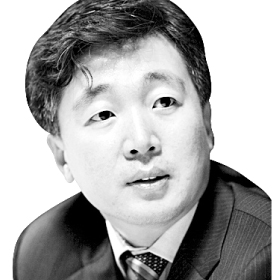Aim at voters in their 40s

The author is an editorial writer of the Joongang Ilbo.
When the mass stress of the people tired from a face mask shortage was at its height, a friend told me, “The ruling party will win the April 15 parliamentary elections unless they are held right now. The ruling party has election masters, but the opposition has test masters.” I thought it was wishful thinking of the friend who was involved in student movement with ruling party members. But I was wrong.
In a column for a newspaper, a key ruling party member wrote, “The most hopeful scenario is that domestic Covid-19 crisis is settled at the Shincheonji church and patients increase rapidly in the United States and Europe so that Korea’s response gets a positive review.” The op-ed was published on March 3, when 600 people tested positive in Korea a day and the United States had about 100 patients. When no one thought Covid-19 was a favorable factor for the ruling party, this ruling party figure saw two moves ahead and devised election strategy. As the crisis response is evaluated relatively, not absolutely, people’s assessment of the Moon Jae-in administration’s disease control quickly changed from “poor” to “outstanding,” and the results of the April 15 general elections were the same as the scenario suggested by the ruling party figure.
The ruling party accurately predicted the Covid-19 crisis and integrated it with its election strategies. Based on the analysis, the ruling party accurately identified the issues to be promoted during the campaign — and what not to do — and led the election campaign at its pace. The surging complaints of getting rejected at foreign airports suddenly turned into the pride that Korea’s status is at the highest in history. The ruling party was also careful not to evoke a response from exaggerated public relations. In contrast, the opposition party was headed to a downfall with noisy nomination process, vulgar remarks and chaotic follow-up process.
But the election outcome cannot be explained with circumstantial factors alone. We should consider more important structural issues. The higher voter turnout proves that the right wing also was united this time. In the districts, the ruling Democratic Party got 49.9 percent of the votes, whereas the opposition United Future Party got 41.5 percent. The 8.4 percent difference led to a landslide victory and crushing defeat. The problem is that 41.5 percent is effectively the maximum that the right-wing party can get.
The most solid supporters of the Moon Jae-in administration and the ruling party are voters in their 40s, well illustrated in various polls. In a Gallop Korea poll on President Moon’s performance on April 6 and 7 — shortly before the general election — 57 percent of the respondents said he was doing great, while 35 percent said he was not doing well. Among the voters in their 30s and 40s, a whopping 70 percent said Moon was doing great. Voters in their 40s have a higher percentage of ruling party supporters than those in their 30s, and 71 percent of office workers supported the president. White-collar workers in the 40s, who are seen as pursuing stability, seem to give full support to the ruling party.
The people in their 40s were born in the 1970s, when Korea got over absolute poverty, and they went to college in the 1990s after democratization was achieved. In the outside world, the ideological confrontation ended with the Cold War in the outside world, but Korea had only just gotten out of military dictatorship, and the suppressed progressive ideologies and historical views emerged as the mainstream of intellectual society.
People in the early and mid-40s were educated by the members of the teachers’ union and are free from anti-communist propaganda. The Asian Financial Crisis they experienced when they started their career at workplaces influenced their political tendency and values. I presume that such backgrounds made them more attracted to distribution and fairness over growth, peace over security.
They are rising as the backbone of the Korean society. Unless the conservative opposition wins their hearts and nurtures leaders in the age group, the opposition party has no future.
People pursue stability over change as they grow old. It is no exaggeration to say that the political topography of Korea depends on the choice of the people in their 40s at the threshold of middle age. For Korea not to lose direction, the weakened right wing needs to be strengthened to find a balance. The conservatives need to become younger. The target that the conservatives must embrace first is the generation born in the 1970s.
JoongAng Ilbo, April 23, Page 28










with the Korea JoongAng Daily
To write comments, please log in to one of the accounts.
Standards Board Policy (0/250자)